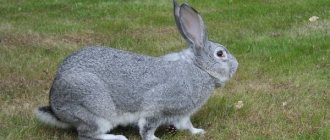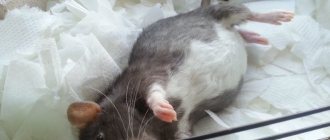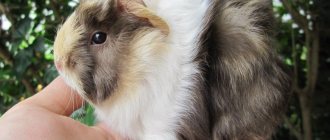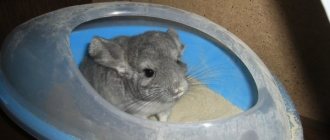Chinchillas are adorable pets, but they are very cautious and shy. A chinchilla lives at home for 6–10 years. Female chinchillas are usually larger than males. Body weight varies from 400 to 600 g.
Long-tailed chinchillas are naturally found in the Andes Mountains in South America. These rodents are known for their long ears and soft, luxurious fur. Chinchillas have the thickest fur of all land animals - more than 20,000 hairs per cm2. In most animals, each hair grows from a separate hair follicle, while in chinchillas there are more than 50 hairs in each. It is not surprising that a real hunt began for their unusual skins.
The history of trade in these skins began in the 15th century and by the end of the 19th century, chinchillas practically disappeared from the wild. Nowadays, chinchillas are increasingly bred as pets.
Chinchilla: description
Until now, scientists are racking their brains over which animal is the ancestor of the chinchilla. As a result of archaeological finds in the Cordillera, scientists were able to familiarize themselves with prehistoric fossils, which in appearance are similar to a chinchilla, while the size of the prehistoric animal was much larger. Scientists have determined that the remains of this animal are at least 40 thousand years old, so we can assume that the chinchilla is a very ancient animal. It should also be recalled that the ancient Incas depicted these animals on rocks, since such images have survived to this day.
The Incas used the soft skins of these animals to make various items of clothing, although the Incas are not considered to be the first to be interested in the fur of these rodents. It is believed that the pioneers in this matter are the Chyncha Indians. Experts also suggest that the name “chinchilla” appeared thanks to this tribe, since the name of the tribe and the animal sounds almost the same.
The Incas valued the fur of this animal highly enough, so they constantly controlled its production so as not to harm the overall population of these animals. Unfortunately, at the end of the 15th century, when the Spaniards appeared on the mainland, the total number of these valuable animals began to decline sharply due to the ruthless hunting of these rodents. As a result, countries such as Chile, Bolivia and Argentina have legally banned the hunting of chinchillas, as well as their export. There are serious penalties for illegal hunting.
The chinchilla is a rodent of the chinchilla family of the same name.
There are two types of similar animals found in nature:
- Short-tailed (coastal) chinchilla.
- Long-tailed (mountain) chinchilla.
Mountain chinchillas prefer to live in mountainous areas, at altitudes of more than 2 thousand meters above sea level. This animal is distinguished by its large size and thicker coat. In addition, these animals have a hooked nose, which allows the animal to breathe cold mountain air without problems. Coastal chinchillas are somewhat smaller in size, while their tail and ears are somewhat longer compared to their mountain relatives.
Currently, experts believe that the mountain species of chinchillas has disappeared completely, although local residents of some mountainous regions of Chile and Argentina claim the opposite.
Interesting moment! The first chinchilla farm was organized by the American Matios Chapman. He is considered the first person to bring these animals to the United States. He began breeding chinchillas on a farm to supply clients with valuable fur for making some valuable items of clothing. After him, many began to practice breeding these animals on their farms.
Chinchilla - All about the rodent species | Type of rodent - Chinchilla
Appearance and features
Long-tailed chinchillas grow in length no more than 0.4 meters, with a tail length of no more than 0.2 meters. The ears are long, reaching 6 cm in height, rounded in shape. In comparison with the body, the head is considered large, while the muzzle is round in shape. The eyes are relatively large, but attractive, with vertical pupils. The whiskers (vibrissae) reach a length of about 10 cm. With the help of these organs, the animals easily navigate in the dark. Adults weigh no more than 1 kilogram, while males are somewhat smaller than females.
The fur of the animals is very fluffy, soft and pleasant to the touch. The exception is the tail, which is covered with stiff bristles. The main color is gray-blue (ashy), while the belly area is painted in light milky shades. Although there are individuals of other colors, this is rather an exception to the rule.
There are 20 teeth in a chinchilla's mouth, 16 of which are molars and grow throughout life. Chinchillas, compared to other types of rodents, are considered long-livers, as they can live for almost 2 decades. The chinchilla has small limbs, with the front ones armed with 5 fingers, and the rear ones with 4. With the help of longer hind limbs, the animals make long jumps. Thanks to a well-developed cerebellum, the animals have simply unique coordination, which allows them to conquer mountainous territories without any problems.
This rodent is interesting because its skeleton tends to shrink in certain, especially threatening situations. In case of any threat, this animal easily penetrates the smallest crevice. Another unique feature of the chinchilla is the fact that the animal practically does not sweat, since it does not have sweat glands. This means that there is no odor coming from this animal.
Where do they live?
The only habitat in our time is associated with South America, or more precisely, with the Cordillera and Andes mountain ranges. Animals are found in Argentina and Venezuela. The element of chinchillas is the highlands of the Andes, at altitudes up to 3 kilometers.
These small animals easily withstand the spartan harsh conditions when cold winds blow throughout the year. In summer, the ambient temperature does not exceed +23 degrees, and in winter there are frosts down to -35 degrees. In such conditions there is practically no precipitation, so chinchillas do not like water treatments. They clean their fur by bathing in the sand. The chinchilla's coat is poorly resistant to moisture.
A chinchilla's nest can be found in various crevices, among rock piles, and in small caves. Often, the animals themselves dig holes in order to form a shelter for themselves, hiding in it from various enemies. Much more often they use the burrows of other animals as their shelters. To see with your own eyes a chinchilla living in natural conditions, you will have to visit Chile. In other places and territories of other countries, the animal is so small in number that it is almost impossible to find it in nature. Even in Chile, the populations of these animals are under threat.
What do they eat?
The basis of the chinchilla's diet is plant foods, which are not very diverse in mountainous areas.
Chinchilla eats:
- Various herbs.
- Small bushes.
- Cacti.
- Mosses and lichens.
Animals replenish their body's moisture through dew and cacti, which are characterized by containing large amounts of moisture. These animals feed on the bark and roots of various plants, as well as their fruits. Their diet also includes various insects. When kept in captivity, the diet of these animals is much more varied, since the owners of these animals purchase special food. As food, the animal can be given fresh grass, as well as various vegetables, berries and fruits. They will happily chew on a crust of bread, dried fruits and nuts. These rodents eat hay in large quantities. You can safely feed chinchillas what hares or guinea pigs eat.
Living in natural conditions, these animals do not experience problems with the digestive system, despite the fact that the animals mainly feed on green vegetation. This is due to the fact that many plants contain tannins, which help animals with the functioning of the digestive system. Chinchilla rats live next to chinchillas and stock up on food for future use. Chinchillas often use these supplies, leaving their neighbors without food.
Behavior and lifestyle
Since there are very few of these animals left in natural conditions, very little is known about their life activities. In this regard, all observations were carried out in captivity. It was possible to establish that chinchillas prefer to lead a collective lifestyle. Each flock can consist of 5 pairs of animals or more. Group activity allows animals to more successfully resist external negative influences. Each flock has an individual that monitors the living space while the rest of the family feeds. In the event of any threat, this animal gives a signal in the form of a whistle and the animals immediately hide in their shelters.
These rodents prefer to lead a crepuscular lifestyle, as they see perfectly both during the day and at night. During the daytime, the chinchilla tries not to leave its hiding places. With the help of long whiskers, animals are able to navigate perfectly in the dark, and also easily find food for themselves. Large ears also help the animal, since fine hearing allows it to react to any sounds in advance. A well-developed vestibular apparatus allows the animal to easily and quickly overcome any obstacles, which is very important in mountain conditions.
Important point! As a rule, the head of the chinchilla family is the female. In addition, she is large in size compared to the male.
In those natural places where such animals live, there is practically no rain. To cleanse their fur of various parasites or odors, animals have to “bathe” in volcanic sand. The peculiarity of these living creatures is that in case of danger, the chinchilla easily gets rid of its fur. When a predator manages to grab the animal’s fur with its teeth, a piece of it remains in the predator’s teeth, and in the meantime the chinchilla finds itself in its shelter.
The behavior of these pets does not contain aggression towards humans. Moreover, the animals are affectionate and good-natured. These animals are easily tamed, so they quickly get used to going to the tray. Despite this, the chinchilla has a very freedom-loving and independent disposition, so it is unlikely that it will be possible to force the animal to do what it does not like. They can be stubborn, but only bite on rare occasions. It is worth noting that each animal has its own personality.
What kind of animal is this Chinchilla? Is it worth purchasing it?
Social structure and reproduction
It was previously noted that chinchillas are social animals that form numerous groups. Pairs form once and for life, with the female occupying a dominant position in the family. Upon reaching 6 months of life, the female is ready to reproduce, while males become sexually mature at 9 months. A female can become pregnant several times a year.
The female carries her offspring for 3 and a half months. As a rule, the female gains excess weight, and closer to childbirth she becomes inactive. One or two cubs are born, although it happens that the female gives birth to 3 babies. When born, the cubs are not as helpless as compared to other types of rodents. Although the creatures are tiny, they are quite formed and practically do not differ from their parents. The body of small animals is covered with a layer of fluffy fur, teeth are formed in the mouth, and the eyes are open. In addition, the offspring can move.
The weight of the cubs depends on their number, so the babies can weigh from 30 to 70 grams. After just one week, they gradually begin to get used to plant foods, but almost until 2 months of age the female continues to feed them with her milk. Females are quite affectionate and caring mothers. Compared to other types of rodents, these animals do not have a high birth rate, and in 1 year a female can give birth to 3 cubs. If we talk about young females, their birth rate is even lower.
Natural enemies of chinchillas
These animals, which are practically unable to fend for themselves, have plenty of natural enemies. Experts believe that the fox is the most dangerous predator because it is quite patient. Although the fox cannot enter the chinchilla’s shelter, it can patiently wait for hours for its prey at the entrance. And yet, camouflage coloring works, as do excellent reactions, speed of movement and structural features of the skeleton, which allows the chinchilla to quickly penetrate narrow openings into which various predators cannot penetrate.
In addition to the fox, many other predatory animals, as well as birds of prey, which easily cope with their prey in open areas, do not mind having such a prey for dinner.
Important to remember! The chinchilla has plenty of enemies, but the main one is humans. These animals are still mercilessly destroyed today for their valuable fur, although hunting them in any form is prohibited.
Human activity leads to constant deterioration of the environment on our Planet, from which many animals suffer, and the chinchilla is no exception.
The main factors are:
- Constant soil contamination.
- Depletion of food supply.
- Global changes in the Earth's atmosphere.
The negative influence of man is due to the fact that man puts his own benefit first and does not think at all about the animals that inhabit our Planet, as well as about the vegetation that ensures the livelihoods of many animals.
Air humidity
As mentioned earlier, chinchillas live in mountainous areas where the humidity is quite low. From this it is worth drawing a simple conclusion: high indicators will not benefit them, which is why the maximum, but already unfavorable, threshold is 75%.
If the percentage exceeds 70% for a long time, then conditions will be created on the rodent’s body for the formation of various types of fungi, which will subsequently lead to an unpleasant disease - lichen. Within 50–60%, pets will live comfortably, but with lower values it is even better, since the microclimate of the room will be closer to real ones.
Did you know? The name "chinchilla" comes from the name of one of the Peruvian provinces
—
Chincha.
Population and species status
Today we can safely say that these animals are facing complete extinction. This mainly concerns chinchilla populations in the wild. According to experts, over the past 15 years the total number of these animals has decreased by almost 90 percent. In 2022, scientists knew of only 42 colonies of animals living within the South American continent. Scientists also believe that there are so few animals left that there is no need to talk about an increase in the population.
Interesting moment! A chinchilla fur coat is valued at $20,000, so it’s not surprising that these animals are so mercilessly destroyed. To sew one fur coat, you will have to destroy at least a hundred adult individuals.
They began sewing such fur coats in Europe in the 19th century. From 1828 to 1916, about 7 million skins were exported from Chile, and in total up to 21 million animals were destroyed and exported. The figure is such that the hair on the head rises spontaneously. Only in 1898 were laws passed prohibiting hunting and export. Unfortunately, it was very late and such bans are no longer able to influence the decrease in the total number.
Features of behavior
You need to be very careful when pairing your pet. If you decide to purchase a second animal, you need to gradually introduce them to each other:
- The animals must live next to each other for three days, the cages must be close to each other;
- Then prepare one common large cage, first carry out disinfection and general cleaning, change the floor covering;
- Leave new friends in a small cage for 3-4 hours;
- After this, introduce the first male into the new “apartment”, he will mark the entire territory;
- And the female is placed last.
By following these rules, you will avoid fights and injuries to your animals.
Changes in the animal's behavior may be associated with the period of estrus. Chinchillas come into heat regularly with an interval of 40-42 days. This period lasts from two to seven days. Hunting is characterized by a decrease in appetite and an increase in activity, while the genitals swell and become hyperemic. If you have a pair of chinchillas, mating will most likely occur at this time and further offspring are expected in 110-115 days. If you do not want offspring, it is better to remove the male during the period of estrus.
It should be noted that a characteristic feature of the chinchilla’s behavior is timidity, and the room with the rodent’s home should be left in silence. All manipulations with the animal should be carried out slowly, without sudden noises and movements, something new should be introduced gradually and stress should be reduced for the animal.
Chinchilla protection
Nowadays, only in Chile can you find this animal living in the wild, but the number of these animals is constantly declining. Scientists have been able to roughly estimate that no more than 10 thousand individuals remain in nature. In this regard, in 2008, the chinchilla was listed in the International Red Book, under the status of “endangered species”.
Zoological specialists have repeatedly made attempts to resettle animals to other territories, but all these attempts have been in vain. The chinchilla refused to live in other, even more comfortable living conditions. The total number of these animals is decreasing due to some negative factors, such as environmental degradation and ongoing poaching.
Even in a nightmare one cannot dream that the populations of these animals have decreased from several tens of millions to several thousand. Unfortunately, it couldn't have happened without people. The chinchilla is a cute animal that does not show any aggression. Moreover, these are animals that can bring a person a lot of positive emotions. Being in captivity, these animals are able to keep company for any person. Unfortunately, man has never been able to become a true friend and defender of wildlife, despite the fact that he has every opportunity.
Conditions close to “wild”
The chinchilla's natural habitat is the desert highlands of South America (Chile, Bolivia, Argentina). The air temperature here remains at 12-18 degrees Celsius. The thermometer in nature can drop lower, and then animals use fluffy fur to keep warm. In rodents living in cold conditions, it is thicker and more lush.
Chinchillas live in the dry, cool conditions of the highlands of South America.
Maintaining the temperature in an apartment below 16 degrees is problematic, and it is not necessary. The optimal figure is 16-18 degrees with a plus sign. But chinchillas also tolerate warmer “weather” well - up to +23 C. But it shouldn’t be hotter in the place where the furry animal lives - otherwise the pet will experience overheating, which will affect its well-being, health and appearance.
Rodents can withstand cold weather much better. There are cases where chinchillas are kept at temperatures close to natural. At the same time, the air temperature can drop to +6 degrees. The main thing is that the animal has a warm house in which it can hide from the cold (analogous to a natural burrow).
It is important that the temperature in the room where the furry is located does not change sharply. To maintain a stable environment, air conditioning and heating devices should be used. Only animals should not experience drafts or excessive heat (for example, from a radiator).
It is better to place the cage away from drafts and heating devices
In winter, during the heating season, it is better to place the cage with the chinchilla away from the window where the radiator is usually located. This will also protect you from drafts from the window. Also make sure that the air flow from the air conditioner (or fan) is not directed towards the animal’s house. A draft does not cool the body of an animal that cannot sweat - but, on the contrary, causes colds and even pneumonia (a disease fatal to chinchillas).
In summer, the animal must be protected from direct sunlight. If your pet stays in the sun for a long time, it will inevitably overheat and get sick. But you cannot completely protect your pet from the light, which he needs like any living creature.
Negative…
- Chinchilla loves to chew everything in its path. Therefore, free movement around the house will result in chewed furniture and wires.
- The animal's house occupies a fairly large space.
- If you forget to keep your chinchilla's house closed, it can run away, and finding your pet will become problem No. 1.
- Quite a lot of dirt and dust from the contents. For example, the formation of dust in the house every time after swimming in the sand.
- The animal does not tolerate drafts, temperature fluctuations, or high indoor humidity.
- The rodent is active at night, which contributes to sleep disturbance due to the noise made by the animal.
- Since this is an exotic animal, if there are any diseases, it is difficult to find a veterinarian who specializes in such species.
Treats for encouragement
To quickly assimilate commands, every correct action of the animal must be reinforced with a treat. During training, the most effective will be the use of chinchillas’ favorite treats:
- dried fruits;
- nuts:
- sunflower seeds;
- berries;
- dried fruits and vegetables.
In this case, the delicacies should be cut into small pieces - each one for one clove. This is necessary so that the chinchilla is not too distracted by snacks during classes.
Under no circumstances should you give your chinchilla sugar, chocolate, candy, salted seeds or crackers as a reward. Such treats will subsequently cause irreparable harm to the health of the animal.











